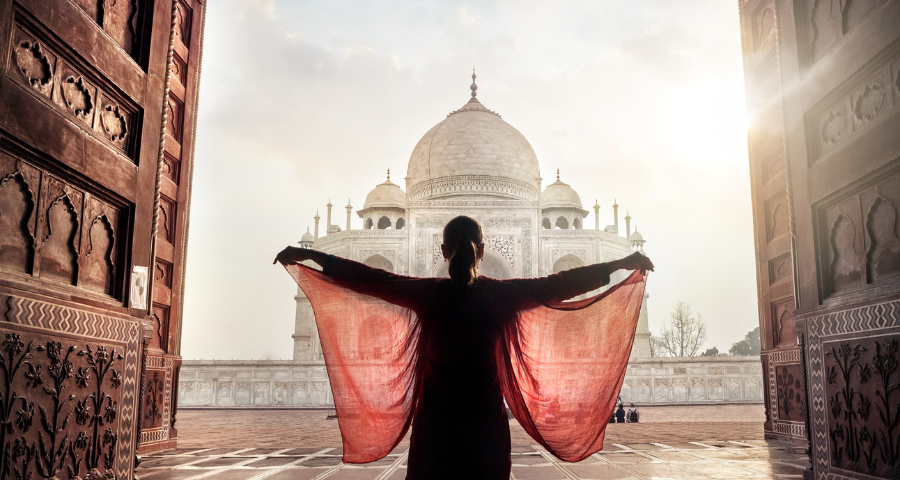The Taj Mahal: A Timeless Symbol of Love and Beauty.The iconic Taj Mahal stands as a testament to enduring love and exquisite craftsmanship. Nestled in the historic city of Agra, India, this masterpiece of Mughal architecture captivates millions of visitors worldwide with its unparalleled beauty and historical significance. Recognized as a UNESCO World Heritage site, the Taj Mahal continues to inspire awe and admiration as one of the most magnificent buildings on Earth.

“Delve deeper into the Taj Mahal’s narrative beyond its iconic facade, uncovering the poignant tale of love and loss that inspired its creation. Explore the intricate architectural details and timeless beauty of this UNESCO World Heritage site, immersing yourself in its enduring legacy and cultural significance.
1.The Architectural Marvel:
Enter through the grand regal gateway, adorned with impressive arches, into the expansive Taj Mahal complex spanning twenty-two acres. As you proceed, the iconic ivory-white marble monument emerges, boasting a majestic central dome flanked by four symmetrical minarets. Adorned with intricate marble inlays, calligraphy, and decorative motifs, the exterior of the Taj Mahal captivates with its ornate beauty.
At the heart of the complex lies the white marble mausoleum, crowned by a towering 35-meter-high dome. Surrounding it are meticulously landscaped Persian-style quadrilateral gardens, evoking the splendor of Paradise described in the Quran. Pavilions, fountains, and reflecting pools add to the Tripplanify ambiance, while the nearby Yamuna River adds a serene backdrop, enhancing the timeless allure of the Taj Mahal.

2.A Tragic Romance:
Behind the grandeur of the Taj Mahal lies a poignant love story, immortalized in white marble. It serves as a testament to the eternal love between Mughal Emperor Shah Jahan and his queen, Mumtaz Mahal, whose untimely demise sparked the creation of this magnificent mausoleum.
Legend has it that Shah Jahan first encountered Mumtaz Mahal in the bustling bazaars of Agra, where she captured his heart with her beauty and grace. Despite initial challenges, including a five-year courtship, they eventually married in 1612. Tragically, Mumtaz passed away after giving birth to their 14th child, leaving Shah Jahan grief-stricken.
In her memory, Shah Jahan embarked on the monumental task of building the Taj Mahal, enlisting the expertise of artisans and craftsmen from across the region. Over the course of twenty-two years and with the labor of 20,000 workers, the majestic marble structure took shape. However, Shah Jahan’s own fate took a sorrowful turn as he was later imprisoned by his son, left to gaze upon the symbol of his enduring love from afar.
3.Poetry in Stone:
The Taj Mahal is a masterpiece of architectural brilliance, adorned with intricate marble inlays and exquisite craftsmanship. Throughout the structure, delicate floral and geometric patterns, along with the use of precious and semi-precious stones, showcase the skilled artistry of the artisans. Gemstones like jasper, agate, and lapis lazuli were meticulously hand-inlaid into the finest marble sourced from the quarries of Makrana. This attention to detail and fusion of architectural styles, blending Persian, Islamic, and Indian influences, make the Taj Mahal a unique symbol of cultural diversity and artistic heritage.
4.Stunning Vistas:
Situated along the curve of the Yamuna River, the Taj Mahal offers breathtaking views, especially during sunrise and sunset. The riverfront creates a mesmerizing reflection of the monument, enhancing its allure. Whether bathed in the golden hues of dawn, the vibrant colors of sunset, or the ethereal glow of the moon, each moment offers a different perspective of the Taj’s grandeur. Visitors can explore various viewpoints around the complex to capture the monument’s magnificence from different angles, ensuring an unforgettable experience that leaves a lasting impression.

Our Insider Tips for Visiting the Taj Mahal:
Best Season for the Trip:
Visit during the dry winter season, from October to March, for pleasant weather. Avoid the scorching summer months from April to June and the monsoon season from July to September.
Best Time to Visit:
Arrive early in the morning for sunrise when crowds are minimal, the weather is comfortable, and the lighting is perfect for photography. Allocate two to three hours for exploring the monument and its surroundings.
Stay and Accessibility:
Choose accommodation in Taj Ganj for easy access to the Taj Mahal and nearby attractions. Purchase tickets in advance to avoid long queues. Note that petrol and diesel vehicles are prohibited near the monument, so guests are dropped off 600 meters away and can walk or take an electric cart.
Stay at The Oberoi Amarvilas:
Experience luxury at The Oberoi Amarvilas, offering stunning views of the Taj Mahal from every room. Immerse yourself in Mughal grandeur with elegant furnishings, antique decor, and exemplary hospitality. Enjoy Mughal and international cuisine at the al fresco dinner by the pool or opt for a private dining experience with the Taj Mahal as your backdrop.
Beyond the Taj:
Explore Agra’s key attractions curated by Tripplanify Travels’ specialists to enhance your travel itinerary beyond the Taj Mahal.

Insider Tips for Visiting the Taj Mahal:
Best Season for the Trip:
- October to March: Enjoy pleasant weather during the dry winter season, ideal for exploring the Taj Mahal.
- Avoid: Steer clear of the scorching summer months from April to June and the monsoon season from July to September.
Best Time to Visit:
- Early Morning: Arrive at sunrise for minimal crowds, comfortable weather, and optimal photography conditions.
- Duration: Plan to spend two to three hours exploring the monument and its captivating surroundings.
Stay and Accessibility:
- Accommodation: Choose lodging in Taj Ganj for convenient access to the Taj Mahal and nearby attractions.
- Ticket Purchase: Buy tickets in advance to skip long queues at the entrance gates.
- Transport: Due to vehicle restrictions near the monument, guests are dropped off 600 meters away and can walk or take an electric cart.
Stay at The Oberoi Amarvilas:
- Luxury Experience: Indulge in luxury at The Oberoi Amarvilas, offering breathtaking views of the Taj Mahal from every room.
- Mughal Grandeur: Immerse yourself in Mughal opulence with elegant furnishings, antique decor, and exemplary hospitality.
- Dining: Enjoy delectable Mughal and international cuisine at the al fresco dinner by the pool or opt for a private dining experience with the Taj Mahal as your backdrop.

Beyond the Taj:
Explore Agra: Discover Agra’s other attractions curated by Tripplanify Travels’ specialists to enrich your travel experience beyond the Taj Mahal.
Experience the bustling city of Agra by immersing yourself in its lively, centuries-old bazaars and architectural marvels. Indulge in a culinary journey through royal delicacies and street foods, each carrying the rich heritage of the Mughal Empire. Gain insightful knowledge about the culinary legacy of the Mughals from our knowledgeable guides.
If you were curious about what awaits you at the Taj Mahal, we hope this guide has provided the answers you seek. Whether you’re planning a trip to Agra or embarking on a Northern India adventure, our team of India travel experts is here to craft a personalized and immersive experience tailored to your preferences. Contact us to begin planning your unforgettable journey today.






3 Comments
Id vim facilis ceteros percipit, altera phaedrum sea at, te alia novum praesent sit. Ne justo mazim delenit eam, pri ex brute interpretaris, invenire.
Praesent finibus congue euismod. Nullam scelerisque massa vel augue placerat, a tempor sem egestas. Curabitur placerat finibus lacus.
Ut enim ad minim veniam, quis nostrud exercitation ullamco laboris nisi ut aliquip ex ea commodo consequat. Duis aute irure dolor in reprehenderit.